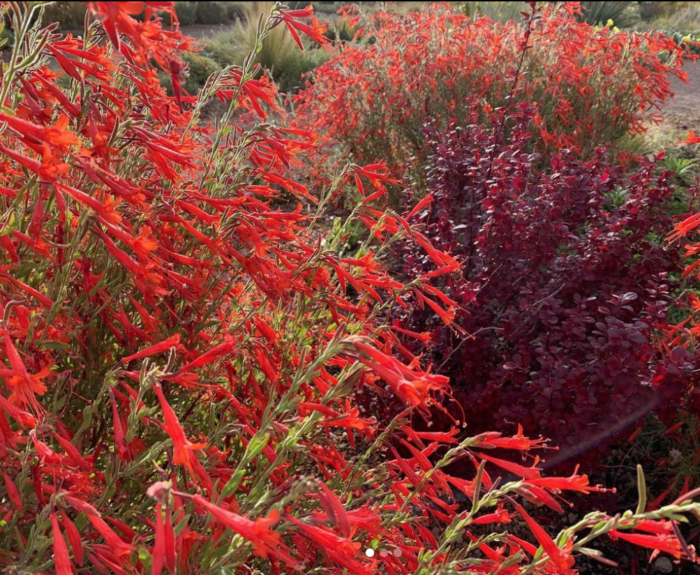
Today’s photos are from Bryan Fischer, who gardens in northern Colorado and embraces the dry climate there to create beautiful gardens.
 Volunteers help Bryan keep the shortgrass section of his prairie garden in shape. Using lots of native, locally adapted plants makes for a beautiful, water-wise garden. Notable plants here include Nassella tenuissima (Mexican feather grass, Zones 6–9) Oryzopsis hymenoides (rice grass), Gutierrezia sarothae (broom snakeweed, Zones 6–8), Liatris punctata (dotted liatris, Zones 4–9), and Lupinus argenteus (silvery lupine, Zones 3–9).
Volunteers help Bryan keep the shortgrass section of his prairie garden in shape. Using lots of native, locally adapted plants makes for a beautiful, water-wise garden. Notable plants here include Nassella tenuissima (Mexican feather grass, Zones 6–9) Oryzopsis hymenoides (rice grass), Gutierrezia sarothae (broom snakeweed, Zones 6–8), Liatris punctata (dotted liatris, Zones 4–9), and Lupinus argenteus (silvery lupine, Zones 3–9).
 Erica carnea (Zones 5–9) is a super-early spring-blooming miniature shrub that looks delicate but is actually quite durable. It is one of the few members of its family that will thrive in the alkaline soils of Colorado.
Erica carnea (Zones 5–9) is a super-early spring-blooming miniature shrub that looks delicate but is actually quite durable. It is one of the few members of its family that will thrive in the alkaline soils of Colorado.
 Mahonia repens (Zones 5–8, aka Berberis repent) is a beautiful little ground cover. Bryan grew a bunch of it from seed, and this individual seedling had these beautiful leaves with extra-long spines on the leaf margins, giving it an unusual texture.
Mahonia repens (Zones 5–8, aka Berberis repent) is a beautiful little ground cover. Bryan grew a bunch of it from seed, and this individual seedling had these beautiful leaves with extra-long spines on the leaf margins, giving it an unusual texture.
 Big sweeps of wild Antennaria (pussy toes, Zones 3–8) make a beautiful display in this meadow. Wild scenes like this are a great inspiration for creating beautiful gardens in this climate.
Big sweeps of wild Antennaria (pussy toes, Zones 3–8) make a beautiful display in this meadow. Wild scenes like this are a great inspiration for creating beautiful gardens in this climate.
 A closer look at the antennaria shows the individual clusters of tiny white flowers rising above the mats of tiny foliage.
A closer look at the antennaria shows the individual clusters of tiny white flowers rising above the mats of tiny foliage.
 Yellow Physaria and a purple-blue Penstemon make a simple but intense combination of plants. These are native plants that thrive in well-drained, dry conditions and reward the gardener with pretty wonderful displays of spring flowers.
Yellow Physaria and a purple-blue Penstemon make a simple but intense combination of plants. These are native plants that thrive in well-drained, dry conditions and reward the gardener with pretty wonderful displays of spring flowers.
 A monarch butterfly lands on Liatris ligulistylis (Zones 3–8). All species of Liatris are great for butterflies, but this one—which isn’t as commonly grown in gardens—is an absolute magnet for monarchs, and quite beautiful as well.
A monarch butterfly lands on Liatris ligulistylis (Zones 3–8). All species of Liatris are great for butterflies, but this one—which isn’t as commonly grown in gardens—is an absolute magnet for monarchs, and quite beautiful as well.
 An over-the-top wild stand of Castilleja (probably Castilleja miniata, Zones 4–9). This beautiful plant is a hemiparasite—meaning that while it does photosynthesize and produce its own food, it also attaches to the roots of plants around it to siphon off extra water and nutrients. That unusual growth pattern makes it a little difficult to cultivate in gardens sometimes, but it has to be one of the most beautiful wildflowers of western North America.
An over-the-top wild stand of Castilleja (probably Castilleja miniata, Zones 4–9). This beautiful plant is a hemiparasite—meaning that while it does photosynthesize and produce its own food, it also attaches to the roots of plants around it to siphon off extra water and nutrients. That unusual growth pattern makes it a little difficult to cultivate in gardens sometimes, but it has to be one of the most beautiful wildflowers of western North America.
 The genus Epilobium (formerly Zauschneria, Zones 5–9) has wonderful displays of intense red flowers and is a great choice for dry gardens. This particular individual is an exceptional seedling that blooms earlier and heavier than most other varieties.
The genus Epilobium (formerly Zauschneria, Zones 5–9) has wonderful displays of intense red flowers and is a great choice for dry gardens. This particular individual is an exceptional seedling that blooms earlier and heavier than most other varieties.
 Prairie gardens often peak in the fall. Here, this one is full of blooms and the tawny colors of fading grasses before the onset of intense winter cold.
Prairie gardens often peak in the fall. Here, this one is full of blooms and the tawny colors of fading grasses before the onset of intense winter cold.
To see more from Bryan, check out his instagram: @b.w.fisch
Have a garden you’d like to share?
Have photos to share? We’d love to see your garden, a particular collection of plants you love, or a wonderful garden you had the chance to visit!
To submit, send 5-10 photos to [email protected] along with some information about the plants in the pictures and where you took the photos. We’d love to hear where you are located, how long you’ve been gardening, successes you are proud of, failures you learned from, hopes for the future, favorite plants, or funny stories from your garden.
Have a mobile phone? Tag your photos on Facebook, Instagram or Twitter with #FineGardening!
Do you receive the GPOD by email yet? Sign up here.
Fine Gardening Recommended Products

Gardener's Log Book from NYBG
Fine Gardening receives a commission for items purchased through links on this site, including Amazon Associates and other affiliate advertising programs.

Wagner's 52003 Classic Blend Wild Bird Food, 6-Pound Bag
Fine Gardening receives a commission for items purchased through links on this site, including Amazon Associates and other affiliate advertising programs.

The Regenerative Landscaper: Design and Build Landscapes That Repair the Environment
Fine Gardening receives a commission for items purchased through links on this site, including Amazon Associates and other affiliate advertising programs.


















Comments
These photos communicate a loose and free garden, but it seems as though some judicious additions of plants are adding extra drama and richness. Bryan seems to have well navigated the limited water available while still orchestrating colorful seasonal events. Inspiring!
Looks fabulous. I'd love to see more. A true work of love! Gorgeous plants!
Beautiful natural drifts. . . how large is your prairie garden? Thank you for sharing your beautiful garden views.
So different from the land & climate in Pennsylvania, I haven't been in Colorado since I was very young, so I'm amazed- now as an adult- at how any gardener could create such a beautiful garden with so many challenges!
I just love your prairie garden...I've read about Penstemon thriving in climates that tend to be dry and yours is fabulous!
The Mahonia you grew from seed - oh wow- you should collect seed from it and try to cultivate more like it!
I love the garden photo with the winding path and the volunteers- it's a garden yet it's so natural, it's almost as if "mother nature" placed everything perfectly.
This is so stunning!
Thank you, thank you, thank you for showing this beautiful garden! As someone who also gardens in the northern high plains (semiarid, zone 3-4, alkaline clay) I salute you.
Do you have a website?
So many beautiful vibrant colors. Excellent job.
MY OH!!! We so rarely get to see pictures of this part of the country and yours are simply marvelous! Certainly a different kind of lusciousness and vibrancy of colors. Thank you so very much for taking the time to share with us all!
Log in or create an account to post a comment.
Sign up Log in